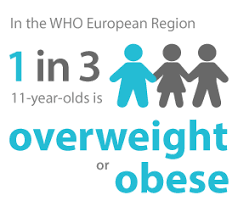EU Action Plan on Childhood Obesity
Childhood obesity is one of the most serious public health challenges of the 21st century. The problem is global and is steadily affecting many low- and middle-income countries, particularly in urban settings. The prevalence has increased at an alarming rate. Globally, in 2016 the number of overweight children under the age of five, is estimated to be over 41 million. Almost half of all overweight children under 5 lived in Asia and one quarter lived in Africa.
The WHO Member States in the 66th World Health Assembly have agreed on a voluntary global NCD target to halt the rise in diabetes and obesity. The prevalence of overweight and obesity in adolescents is defined according to the WHO growth reference for school-aged children and adolescents (overweight = one standard deviation body mass index for age and sex, and obese = two standard deviations body mass index for age and sex).
Key facts
- Worldwide obesity has nearly tripled since 1975.

- In 2016, more than 1.9 billion adults, 18 years and older, were overweight. Of these over 650 million were obese.
- 39% of adults aged 18 years and over were overweight in 2016, and 13% were obese.
- Most of the world's population live in countries where overweight and obesity kills more people than underweight.
- 41 million children under the age of 5 were overweight or obese in 2016.
- Over 340 million children and adolescents aged 5-19 were overweight or obese in 2016.
- Obesity is preventable.
More information of World Health Organisation: Obesity and overweight
The European Commission reacted to the challenge of overweight and obesity by adopting the EU Action Plan on Childhood Obesity 2014-2020. Goal is to contribute to halting the rise in overweight and obesity in children and young people by 2020. The action plan focuses on children, because “by learning and adopting healthy habits when young, the chance that such habits will be sustained into adulthood is greatly increased” .
The action plan encourages schools and pre-schools “to limit access to … less healthy food options” and to create “environments in which health and wellbeing are promoted and the healthy option becomes the easy option”. And it is mentioned that schools need to provide children and young people with access to free drinking water as an alternative to sugar-sweetened beverages.


